Oakland County International Airport (PTK)
Oakland County International Airport (PTK) is the second busiest airport in the state of Michigan, behind Detroit (DTW). The airport supports numerous flight schools, recreational general aviation, corporate aviation, air cargo, seaplanes, and helicopter operations. View a printable Pilot Handbook of the PTK information found on this Web page.
Know Before You Go
- RWY configuration consists of two parallel RWYs, with staggered thresholds, designated RWY 9L/27R and RWY 9R/27L.
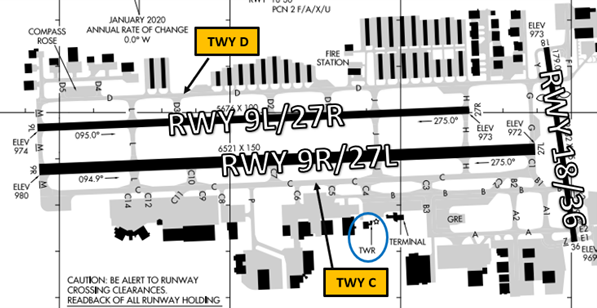
- Note that RWY 9R/27L is longer and wider.
- A third RWY designated RWY 18/36 does not intersect RWY 9L/27R and 9R/27L.
- The RWY 18 threshold is displaced.
- The TWY system provides access to business and services located on the east and west sides of the airport. TWY C and TWY D run full-length to the parallel RWYs.
The airspace at PTK is Class D and underlies Detroit Class B airspace. (Refer to Sectional Chart.)
PTK TWR
Hours of Operation – 0600L-0000L
Administrative Office Open 0830L to 1700L - M through F
Business Phone 248-666-3900
Below find various PTK-specific information and things to be aware of, as well as general information to inform your preflight planning. This will be reviewed quarterly and updated as needed. This information is to supplement the From the Flight Deck Videos that are produced by the FAA Runway Safety Group. Here you will also find information provided by the local air traffic controllers at the airport where you intend to fly. The information is subject to change. Not for navigation or legal* pre-flight action. Always refer to official pre-flight materials such as, but not limited to, NOTAMs, airport diagrams, VFR charts and airport construction notices for the latest airport-specific details.
Hot Spots
There are no Hot Spots at KPTK.
Wrong Surface Intersection Takeoff
- Pilots have turned in the wrong direction when cleared for an intersection takeoff.
- Prior to entering the RWY and again when lined up on the RWY, check the Magnetic Compass and the Horizontal Situation Indicator (HSI), if installed, to verify that the aircraft is pointed in the correct direction.
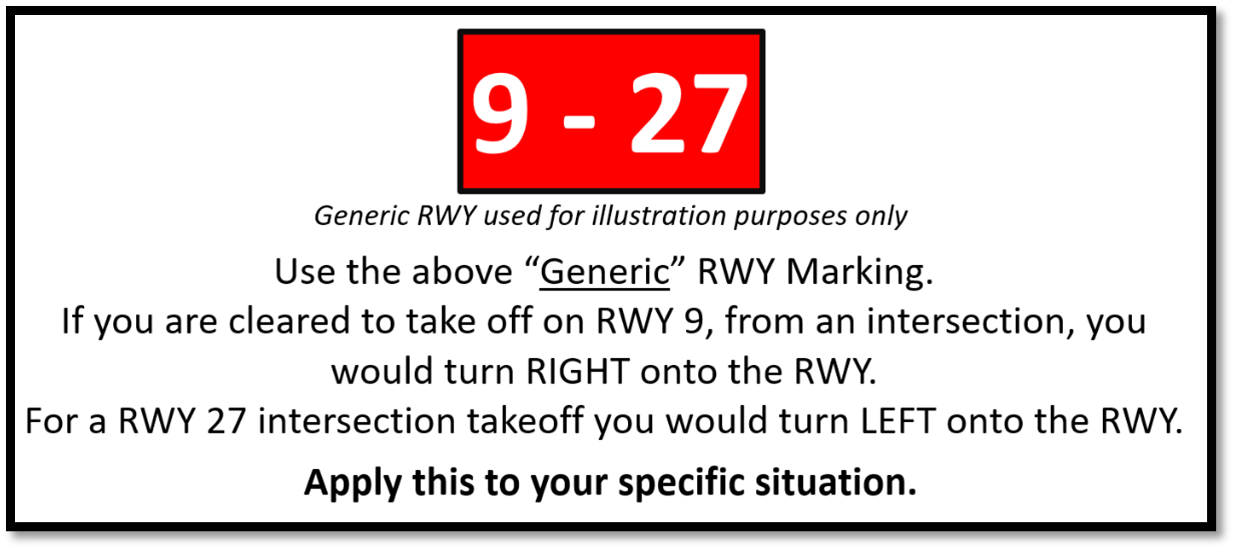
Wrong Surface RWY Landings (See Arrival Alert Notices)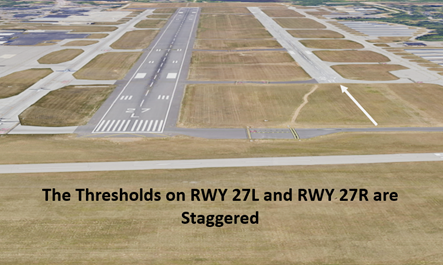
- Parallel RWYs present the risk of landing on the wrong RWY.
- If available, back up all visual approaches with an instrument approach.
- Staggered thresholds on parallel RWYs increase this risk.
- When RWYS are staggered, remember that the first RWY that becomes visible may not be your assigned RWY.
Wrong Surface TWY Landings (See Arrival Alert Notices)
- Whenever a TWY runs parallel to a RWY, the risk of a TWY landing increases.
- If available, back up all visual approaches with an instrument approach.
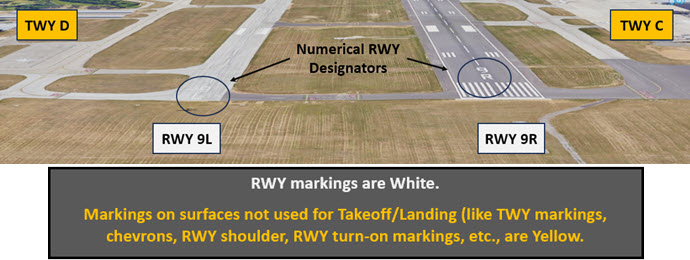
General
- PTK has extensive pilot training operations.
- Pilots must state their callsign in every transmission.
- RWY 18/36 is unlit and is unavailable between sunset and sunrise.
Traffic Patterns
- Use caution for traffic on the opposite base leg for the parallel runway.
- If you want a short approach, advise the TWR prior to takeoff or prior to starting crosswind turn.
Surface Risk – Movement Area Cautions
- Be alert for extensive helicopter operations around the airport, especially to/from the midfield ramp and the southeast corner of the field.
- TWY D and TWY C are near the parallel RWYs. Watch for aircraft exiting the RWYs.
- RWY 18/36 is often used to taxi aircraft from one side of the field to the other without having to cross the parallel RWYs. However, RWY 18/36 intersects with the Runway Safety Area (RSA) of RWY 9R/27L. When there is traffic on RWY 9R/27L.
- Expect to be held “on the numbers” when taxiing south on RWY 18.
- Expect to hold short on TWY B when taxiing north on RWY 36.
- Use caution near RWY 18/36 due to proximity to TWYs and FBOs.
RWY Crossings
- The airport layout allows for crossing from the north side of the airport to the South side (and vice versa) via TWYs M, L, J, H, G, and RWY 18/36
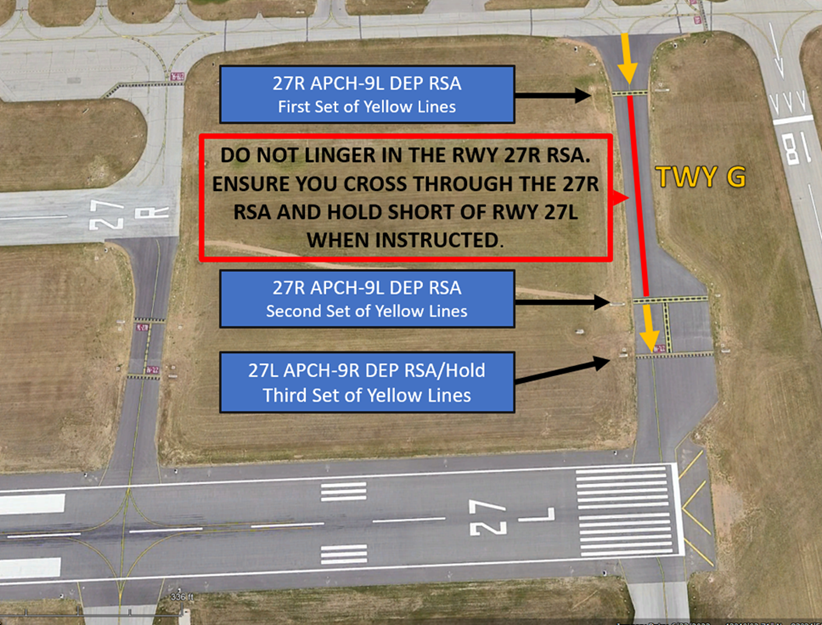
- Pilots may be instructed to taxi on RWY 18/36 to get to the other side of the field during periods of busy traffic.
- All crossings are expected to be without delay. Controllers often emphasize “no delay” in the crossing instruction.
- It is uncommon for the controller to be able to cross both RWYs at the same time. Do not allow a sense of urgency to cross one of the parallel RWYs distract you from holding short of the other RWY.
RWY Holding Position Markings
- The Runway Safety Area (RSA) for RWY 27R/9L intersects with TWY G. RSA Information.
- This sometimes leads to confusion for the pilots that are taxiing to RWY 27L from the north side of the field.
- Expect for the controller to instruct pilots to hold short of TWY G before proceeding to RWY 27L.
- The controller may tell the pilot to proceed across the first two sets of yellow lines (the RSA boundaries for RWY 27R/09L) and to hold short of the third set of yellow lines (the RSA Hold Short position for RWY 27L).
Departure/Takeoff
- Normally departures will contact TWR on frequency 120.5. When PTK is in a dual TWR configuration, pilots departing RWY 9L/27R will contact TWR on frequency 123.7 and pilots departing RWY 9R/29L shall contact TWR on frequency 120.5.
- After departure, the TWR controller may instruct you to contact the other TWR frequency if you need a turn through the other controller’s airspace.
Arrival/Landing
- Normally inbounds will contact TWR on frequency 120.5.
- When PTK is in a dual TWR configuration, pilots inbound from the north will contact TWR on frequency 123.7 and pilots inbound from the south will contact TWR on frequency 120.5.
- Pilots are expected to exit the RWY at the first available TWY.
- When exiting a RWY, ensure that your entire aircraft is beyond the yellow RWY Holding Position Marking.
- Sometimes you may have to enter a TWY when clearing the RWY. The controllers are aware of and manage aircraft on the TWY accordingly.
Areas of Caution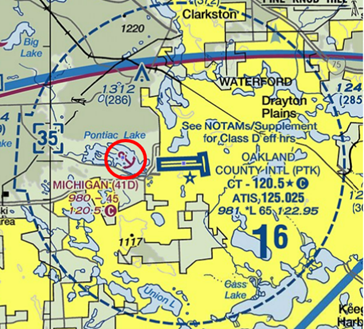
- There is a seaplane base (41D) at Pontiac Lake, immediately west of the airport. Use caution for low level seaplane operations when landing RWY 9R/L or when departing RWY 27L/R.
- There is a highly active practice area to the northeast of PTK. Use caution when departing to the northeast and when inbound to PTK from the northeast for potential opposite direction traffic.
- Avoid flying near the final approach corridor for RWY 9R/27L at or below 3500’ MSL.
Weather
- During cold weather operations, the priority for snow removal is RWY 9R/27L, the associated turnoffs, and TWY C. All other areas of the field have lower priorities.
- On initial contact, advise controllers where you intend to park. They can coordinate with the snow team to clear a path to your hangar/FBO.
Controller Preferences
- Tell Ground Control if you need a run-up prior to taxiing to the RWY. There are multiple run-up areas around the airport. It is preferred that you not block access to the RWY when you complete your run-up while holding short.
- PTK controllers prefer touch-and-go landings to full-stop taxi backs, however, if you advise your intentions on initial contact, your controllers will do their best to fulfill your request.
- Frequency changes are considered to be approved, without coordination, upon exiting Class D airspace, unless instructed otherwise by ATC. Pilots do not need to request a frequency change when they are clear of Class D.
Additional Caution
- TWR is unable to see more than 200’ south of RWY 36 threshold as well as TWY A2 between TWYs A and B.
NOTAMS
- See NOTAMS for the following notices and Letters to Airmen (LTA):
- Closure/Restriction NOTAM Diagram
- VFR Practice Instrument Approaches
- Publication of Airport Frequencies
- Wrong Surface Landing Risk
- Runway Alignment & Overshooting Parallel Runways
